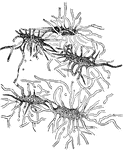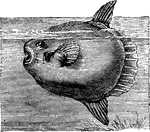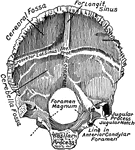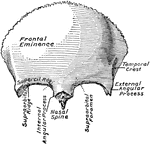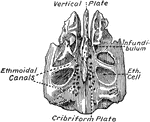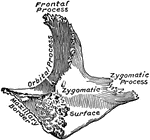Reindeer age articles, Bone points and needles
Bone points and bone needles. Crafted during the Reindeer age.
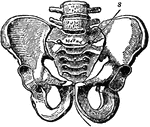
Pelvic Bone, Male
A bony structure located at the bottom of the spine. The human sacrum forms the back part of the pelvis,…

Side View of the Larynx
Labels: T, thyroid cartilage: C, cricoid cartilage; Tr, trachea; H, hyoid bone; E, epiglottis; I, joint…

Back View of the Larynx
Labels: T, thyroid cartilage: C, cricoid cartilage; Tr, trachea; H, hyoid bone; E, epiglottis; I, joint…
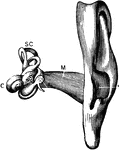
The Auditory Apparatus
The auditory apparatus with the surrounding bone removed. Labels: M, external auditory canal; SC, semicircular…

View of Organs from the Side
The chief organs of the body from the side. Labels: a, arch of the aorta or main artery of the trunk;…
Femur
The thigh bone cut through the middle. Labels: b, hard bone; h and d, spongy bone; ma, marrow.
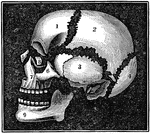
Bones of the Head
A diagram of the bones of the head. Label: 1, frontal lobe; 2, parietal bone; 3, temporal bone; 4, occipital…

Bones of the Foot
The upper surface of the bones of the foot. Labels: 1, the surface of the astragulus or ankle bones,…

Position of the Bone, Cartilage, and Synovial Membranes
A diagram of the relative position of the bone, cartilage, and synovial membrane. Labels: 1,The extremities…
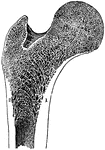
Longitudinal Section of the Femur
The longitudinal section of the extremity of the femur, exhibiting the arrangement of the spongy substance.…
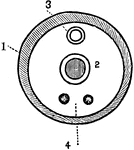
Skeleton of a Cow
A skeleton of a cow shown to illustrate the internal skeleton which all vertebrates share. Labels: 1,…

Skeleton of a Tortoise
A skeleton of a tortoise The ribs of which are expanded, forming the dorsal part of its shell. Labels:…

Skeleton of a Haddock
The skeleton of a haddock. In some species such as the haddock, there is a modified form of the coracoid…
Metacarpal and Phalangeal Bones of the Fingers
The metacarpal and phalangeal bones of the fingers, with their tendons and ligaments. Labels: 1, metacarpal…

A Side View of the Cartilages of the Larynx
A side view of the cartilages of the larynx. Labels: *, The front side of the thyroid cartilage. 1,…

A Section of the End of the Finger and Nail
A section of the end of a finger and nail. Labels: 4, Section of the last bone of the finger. 4, Fat,…
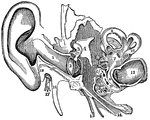
Parts of the Ear
A view of all the parts of the ear, Labels: 1, The tube that leads to the internal ear. 2, The membrana…
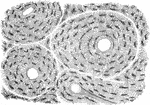
A Magnified View of a Bone
A thin slice of bone, highly magnified, showing the lacunae, the tiny tubs (canaliculi) radiating from…
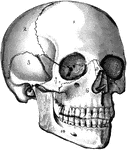
The Skull
The human skull. Labels: 1, frontal lobe; 2, parietal lobe; 3, temporal lobe; 4, the sphenoid bone;…
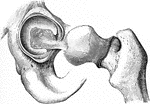
The Mechanism of the Hip Joint
The femur articulates with the hip bone by a ball-and-socket joint. The cup is deep, thus affording…
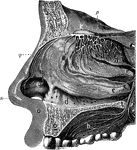
Olfactory System
The olfactory system. Labels: a, b, c, d, interior of the nose, which is lined by a mucous membrane;…

Cells of the Red Marrow
Red marrow occupies the spaces in the cancellous tissue; it is highly vascular, and this maintains the…
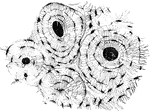
Microscopic Structure of Bone
The bone contains a multitude of small irregular spaces, approximately fusiform in shape, called lacunae,…
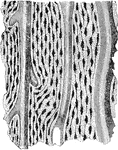
Microscopic Structure of Bone
The bone contains a multitude of small irregular spaces, approximately fusiform in shape, called lacunae,…
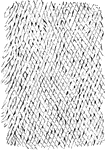
Reticular Structure of a Lamellae
Shown is a thin layer peeled off from a soft bone, which is intended to represent the reticular structure…

Lamellae
Lamellae torn off from a decalcified human parietal bone at some depth from the surface. Labels: a,…
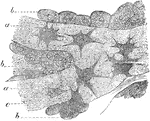
Osteoblasts
Osteoblasts from the parietal bone of a human embryo, thirteen weeks old. Labels: a, bony septa with…
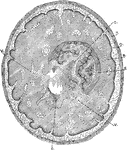
Formation of Compact Bone in a Kitten
Transverse section through the tibia of a fetal kitten. Labels: P, Periosteum. O, Osteogenetic layer…
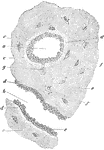
Formation of Compact Bone in a Human
Transverse section of femur of a human embryo about eleven weeks old. Labels: a, rudimentary Haversian…

Dentine and Cement
Section of a portion of the dentine and cement from the middle of the root of an incisor tooth. Labels:…

Development of Teeth
The first step in the development of teeth consists in a downward growth from the Rete Malpighi or the…

Front View of Respiratory Apparatus
Outline showing the general form of the larynx, trachea, and bronchi, as seen from front. Labels: h,…

Back View of Respiratory Apparatus
Outline showing the general form of the larynx, trachea, and bronchi, as seen from behind. Labels: h,…

Malleus
The hammer-bone or malleus, seen from the front. 1, the head; 2, neck; 3, short process; 4, long process.
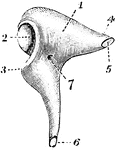
Incus
The incus, or anvil-bone. Labels: 1, body; 2, ridged articulation from the malleus; 4, processus brevis,…
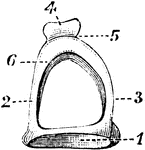
Stapes on Stirrup-Bone
The stapes on stirrup-bone. 1, base; 2 and 3, arch; 4, head of bone, which articulates with orbicular…
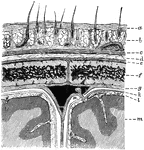
Layers of the Scalp and Membrane of the Brain
Diagram showing the layers of the scalp and membranes of the brain in section. Labels: a, skin; b, subcutaneous…
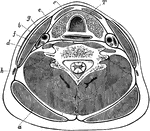
Transverse Section of the Neck
Transverse section through the lower part of the neck, to show the arrangement of the cervical fascia.…
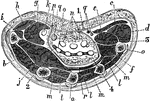
Horizontal Section of the Hand
Horizontal section of the hand through the middle of the thenar and hypothenar eminences. Labels: a,…
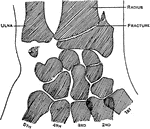
Colle's Fraction of the Radius
Showing the situation of Colle's fracture of the radius, with fracture of the styloid of the ulna. The…
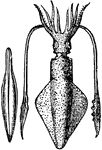
Loligo Vulgaris, with its pen, or internal bone (Lamarck)
"The Common Calmar or Squid. They propel themselves backward through the water with great velocity,…

The Trunkfish (Ostracion)
"The Trunk-fish, or Ostracion, is without scales, but covered with regular, osseous plates, which are…
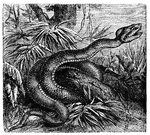
Fer-de-Lance
"The Viperine Snakes have a long, perforated, erectile fang on the maxillary bone, which is extremely…
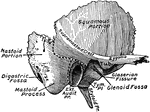
Temporal Bone
The outer surface of the temporal bone. The dotted lines indicate the lines of suture between squamous,…

